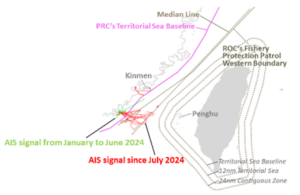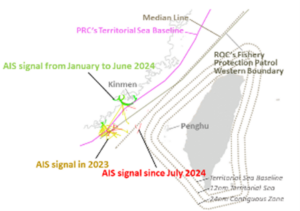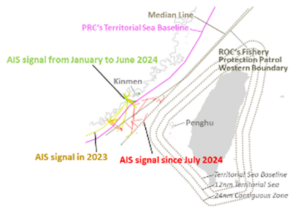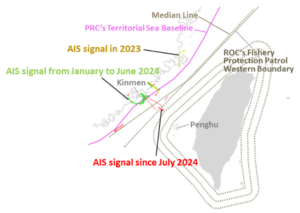
PRC Expands De Facto Jurisdiction in the Taiwan Strait
Publication: China Brief Volume: 24 Issue: 18
By:
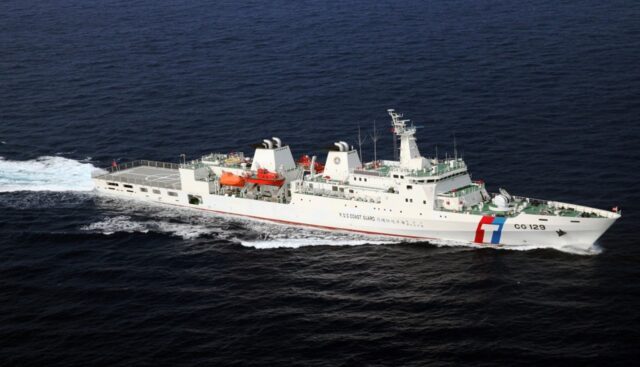
Executive Summary:
- Beijing has begun to assert greater jurisdiction over the Taiwan Strait, with incursions by People’s Republic of China (PRC) government vessels into waters under Taiwan’s jurisdiction set to continue or even increase in number.
- The PRC is trying to blur the reality of the division between itself and Taiwan by ignoring the median line in the Taiwan Strait. This projects a perception that there is nothing remarkable or worth concealing about PRC vessels crossing the median line.
- Recent missions have been assigned to provincial-level vessels (such as the Fujian Coast Guard) rather than those of the central government or the People’s Liberation Army Navy (PLAN). This is done to demonstrate that the management of the Taiwan Strait falls under PRC domestic administrative affairs.
- PRC vessels have avoided direct confrontations with Taiwanese law enforcement units, instead focusing on executing their own missions. This normalizes the presence of PRC law enforcement activities in the strait, aiming to create the perception that PRC management of the Taiwan Strait is a routine matter.
Since July 2024, the People’s Republic of China (PRC) has further intensified its maritime incursions into Taiwan’s waters. For instance, on July 2, a China Coast Guard (CCG) vessel detained the Taiwanese fishing boat Dajinman 88 (大進滿88號) off the coast of Fujian (CNA, July 3). Additionally, on August 17–18, several official vessels, including the Hai Xun 06 (海巡06) under the PRC Ministry of Transport, conducted the “2024 Taiwan Strait Maritime Patrol and Law Enforcement Action (2024年台湾海峡海上巡航执法行动)” within the Taiwan Strait, crossing the median line (Xinhua, August 20). As analysts have observed, the PRC has increasingly engaged in gray-zone operations against Taiwan this year (see China Brief, March 29; July 26). The PRC’s objectives now extend beyond gray-zone incursions. The aim is to assert greater jurisdiction over the Taiwan Strait.
By unilaterally expanding its jurisdiction, the PRC seeks to enhance its administrative control and governance capabilities over the Taiwan Strait, establish customary practices, and legitimize its jurisdictional actions. Previous gray-zone operations mainly involved PRC harassment of other parties without escalating to formal conflict. Since July 2024, such operations have expanded to include harassment of Kinmen, interference with Taiwanese fishing vessels, and new patrol patterns from PRC official vessels.
Increase in PRC Activities in Taiwan Strait
Harassment of Kinmen, beginning in February, was the first step up in PRC gray-zone activities. Taiwan’s outlying islands have experienced increased daily incursions into territorial waters and the expansion where these excursions come from.
Following the “Capsized Chinese Speedboat Incident” near Kinmen on February 14, the Fujian Coast Guard has regularly intruded into the waters under Kinmen’s jurisdiction (CNA, February 15; see China Brief, March 29). According to data released by Taiwan’s Coast Guard Administration, PRC vessels entered Taiwan’s restricted and prohibited waters 30 times between January and June of this year. These activities typically involved one to two fleets of vessels entering Kinmen’s waters once per day.
Starting in July, the PRC intensified the frequency and severity of these incursions. Several incidents involved four coast guard vessels simultaneously intruding into Kinmen’s waters at four separate locations. Sometimes, multiple incursions take place on the same day. Table 1 presents a chronology of PRC government vessels’ activities around Kinmen since February 14, while Figure 1 illustrates the relative positions of the incursions.
The PRC is increasing both the frequency and scope of its activities in the waters surrounding Kinmen, asserting its claims of jurisdiction over these waters more forcefully than in the past. Analysis from Yuyuan Tantian (玉渊谭天), a media outlet under the PRC government’s China Media Group (中央广播电视总台), suggests that CCG has divided into smaller units to conduct law enforcement actions after completing their regular patrol routes since June 25. The report interpreted this trend as an expansion of the PRC’s law enforcement range and a shift toward “round-the-clock (全天候)” operations (BBC, February 21, 2019; Yuyuan Tantian, June 26).
Table 1: Chronology of Chinese Government Vessels’ Activities around Kinmen since February 14
| Date | Maneuver Type | Source |
| February 19 | A sightseeing boat was inspected by the Fujian CCG (2.8 nautical miles northwest of Niaosha Cape, Kinmen; outside the restricted waters northwest of Kinmen) | United Daily News, February 20 |
| February 20 | China Marine Surveillance Ship 8029 entered the restricted waters | Ta Kung Pao, February 26 |
| February 25 | Fujian CCG organized a fleet for law enforcement patrols in the waters near Kinmen | CCG, May 16 |
| February 26 | One Chinese marine surveillance ship and four coast guard vessels entered the restricted waters | CNA, February 27 |
| March 15 | One fleet, 14:00-16:00: two CCG Direct Bureau vessels and three Fujian CCG vessels | China Times, March 15 |
| March 16 | One fleet, one time slot, 08:54-10:06: two CCG Direct Bureau vessels and three Fujian CCG vessels | CNA, 3/16 |
| May 3 | One fleet, one time slot | Xinhua, May 3 |
| May 6 | One fleet, one time slot, 15:30-16:37: four Fujian CCG vessels, south of Kinmen | ROC CGA, May 6 |
| May 9 | Two fleets, one time slot: 15:00-16:30: seven Fujian government vessels, southwest of Liaoluo 15:00-16:30: four Fujian CCG vessels, south of Dadan |
ROC CGA, May 9 |
| May 14 | Two fleets, one time slot:
15:00-17:09: two Fujian CCG vessels, south of Liaoluo 15:00-17:09: two Fujian CCG vessels, south of Zhaishan. |
ROC CGA, May 14 |
| June25 | Two fleets, one time slot:
06:00-08:00: two Fujian CCG vessels, east of Beiding 06:00-08:00: two Fujian CCG vessels, south of Fuxing Islet. |
ROC CGA, June 25 |
| July 11 | Four fleets, two time slots:
0700-0900: four Fujian CCG vessels, east of Liaoluo, southeast of Liaoluo, south of Zhaishan, south of Fengzui 1000-1200: four Fujian CCG vessels, east of Liaoluo, southeast of Liaoluo, south of Zhaishan, south of Fengzui. |
ROC CGA, July 11 |
| July 15 | Four fleets, one time slot:
1500-1700: four Fujian CCG vessels, Fuxing Islet, Zhaishan, Liaoluo, south of Beiding Island. |
ROC CGA, July 19 |
| August 21 | Four fleets, two time slots:
08:50-11:00: four Fujian CCG vessels, Fuxing Islet, Zhaishan, Liaoluo, south of Beiding Island 14:50-17:00: four Fujian CCG vessels, Fuxing Islet, Zhaishan, Liaoluo, south of Beiding Island. |
ROC CGA, August 21 |
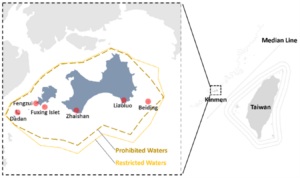
The activities of CCG vessels in these cases have predominantly occurred in the southern waters of Kinmen—the main route between Kinmen and the main island of Taiwan. If the CCG’s objective was solely to harass Kinmen, one would expect incursions from all four cardinal directions into Kinmen’s waters, potentially leading to standoffs or even conflicts with Taiwan’s coast guard. The incidents disclosed by Taiwan’s Coast Guard Administration do not support this scenario, however. The involvement of PRC government vessels in a maritime rescue drill on May 9 in these southern waters, in coordination with PRC fishing vessels, indicates a deliberate assertion by the PRC government of its jurisdiction and routine operational presence around Kinmen.
Since July, Taiwanese fishing vessels operating in the Taiwan Strait have frequently been harassed by the CCG. The most prominent incident occurred on July 2, when the Taiwanese fishing vessel Dajinman 88 was apprehended by CCG and forcibly escorted to a PRC port (ROC CGA, July 3). Although this incident took place within the territorial sea baselines declared by the PRC, the Republic of China (ROC) Ministry of Agriculture, which oversees fisheries, stated that this area is a traditional fishing ground where fishermen from both sides of the Strait have historically operated (ROC Ministry of Agriculture, July 3). The shipowner of Dajinman 88 noted that he has made his living in the waters near Kinmen for decades. This was the first time his vessel had been forcibly detained. In the past, PRC authorities primarily issued warnings to leave the area (CTS News, July 3).
According to reports from Taiwanese media, there have been at least nine incidences of Taiwanese fishing vessels being approached and harassed by the CCG (CNA, July 3; UDN, July 4, July 4, July 16; LTN, July 5, July 16, July 18, July 19, July 21). Figure 2 illustrates the locations where Taiwanese fishing vessels have been harassed by the Chinese coast guard. The locations reveal that most of the vessels were harassed by the CCG to the east of Taiwan’s fishery protection boundary line. Several of these vessels were even harassed east of the median line of the Taiwan Strait. While there have been instances where Taiwanese fishing vessels were occasionally harassed by PRC government vessels, the frequency and intensity of such incidents have escalated since July.
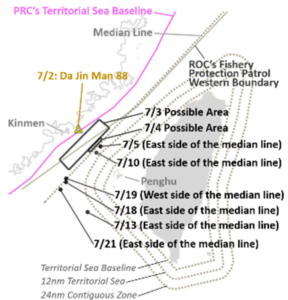
The case of Dajinman 88 is currently the only known instance of a Taiwanese fishing vessel being forcefully detained. It is unclear if this will remain an isolated incident or if the primary focus of CCG actions in the Taiwan Strait will escalate from harassment to forcible boarding and detention as routine measures.
The frequency of Fujian Coast Guard and other PRC government vessels crossing the median line in the Taiwan Strait has increased since July this year. This is confirmed by tracking Automatic Identification System (AIS) data from these vessels. CCG vessels often turn off their AIS signals during operations to conceal their activities, a characteristic often highlighted in studies of PRC gray-zone operations (see SeaLight, August 17, 2023). As such, using AIS signals to observe CCG activities might not provide a complete picture of these gray-zone tactics.
According to the Taiwanese news reports referenced above, at least five vessels from the Fujian Coast Guard have harassed Taiwanese fishermen in the Taiwan Strait. [1] From August 17–18, the Hai Xun 06, a 6,600-ton vessel under the Fujian Maritime Safety Administration, conducted the “2024 Taiwan Strait Maritime Patrol and Law Enforcement Action” (Xinhua, August 20). This vessel also carried out similar missions in the Taiwan Strait in April 2023, prior to the PLA’s military exercises around Taiwan (Xinhua, April 6, 2023). Figure 3 illustrates the operational areas of the Fujian Coast Guard and Hai Xun 06 from July 1 to August 22. Their AIS tracks confirm that the areas where Taiwanese fishing vessels were harassed coincide with the patrol areas of the PRC government vessels.
Comparing the AIS tracks of the Fujian CCG since July of this year with those from the first half of this year and the whole of 2023 shows that these vessels have crossed the median line in the Taiwan Strait more frequently since July this year. Figures 4 to 8 (in the Appendix) illustrate this, showing the AIS signals of five Fujian CCG vessels.
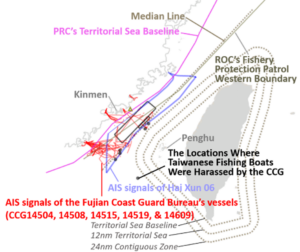
Eroding the Status Quo
There are three implications for the discernible changes in PRC actions in the Taiwan Strait.
First, the PRC is trying to blur the reality of the division between the PRC and Taiwan by ignoring the median line in the Taiwan Strait. During these operations, PRC vessels have often activated their AIS signals. This is distinct from typical gray-zone harassment tactics, as it signals the PRC’s actions to the international community. This projects a belief that there is nothing remarkable or worth concealing about PRC vessels crossing the median line.
Second, missions have been assigned to provincial-level vessels, not those of the central government or the People’s Liberation Army Navy (PLAN). This is done to emphasize that the management of the Taiwan Strait falls under PRC domestic administrative affairs. Deploying Fujian CCG or other provincial-level units of Fujian province is a shift from missions conducted in February and March, which saw larger, thousand-ton class CCG vessels from centrally controlled detachments patrolling around Kinmen. In recent months, there also has not been any indication of PLAN involvement in the strait. This shift by the PRC to deliberately assigning the responsibility for security and management of the Taiwan Strait to “Fujian provincial law enforcement units” underlines the PRC narrative that the Taiwan Strait is a domestic matter.
Third, PRC vessels have avoided direct confrontations with Taiwanese law enforcement units, instead focusing on executing their own missions. This is done to highlight that the PRC’s management of the Taiwan Strait is a routine matter. Although CCG vessels are frequently intercepted and driven away by Taiwanese Coast Guard vessels when they intrude into Kinmen’s waters or cross the Taiwan Strait median line, there have been no intense confrontations between vessels from the two governments. This stands in contrast to the PRC’s encounters with vessels from the Philippines elsewhere in the South China Sea. In some cases, CCG vessels harassing Taiwanese fishing boats east of the Taiwan Strait median line withdrew before Taiwanese coast guard vessels arrived. This suggests that PRC government vessels are trying not to engage with Taiwanese official vessels, implying that the PRC intends to normalize the exercise of its jurisdiction in the Taiwan Strait, thereby presenting its law enforcement activities as routine. Avoiding Taiwan’s official presence allows the PRC to conduct patrols without resistance.
Conclusion
Since July, the PRC has attempted to blur the reality and boundaries of the separation across the Taiwan Strait, emphasize that the management of the Taiwan Strait is a matter of domestic administrative affairs, and normalize the perception that the PRC’s management of the Taiwan Strait is a routine matter. These actions imply that Beijing has begun to assert greater jurisdiction over the Taiwan Strait. It is likely that incursions by PRC government vessels into waters under Taiwan’s jurisdiction will continue or even increase.
Notes
[1] These vessels are CCG14504, CCG14508, CCG14515, CCG14519, and CCG14609.
Appendix 1: Comparative Data on Fujian CCG Vessels’ AIS Signals

